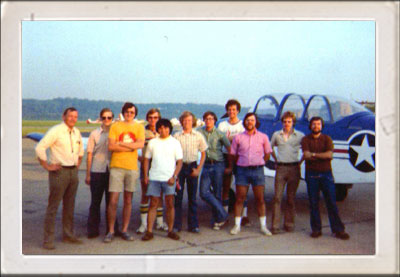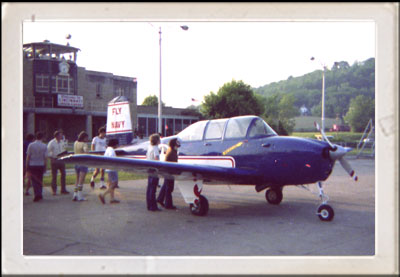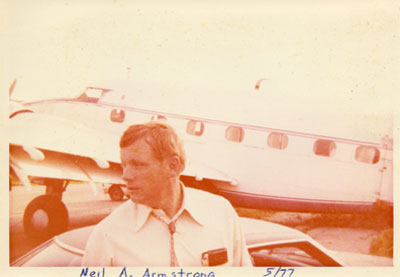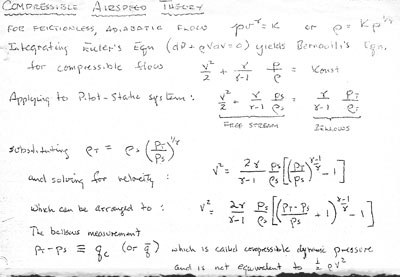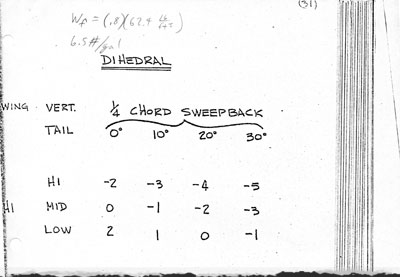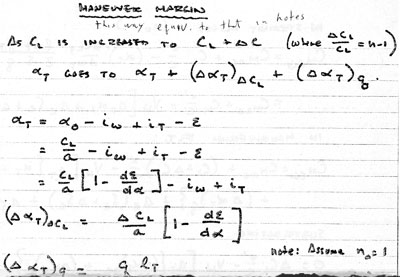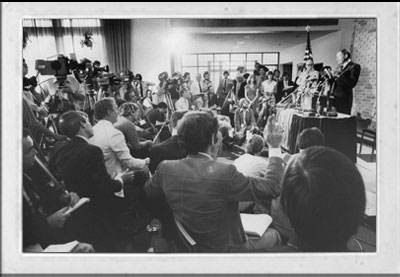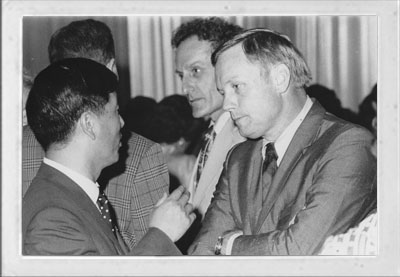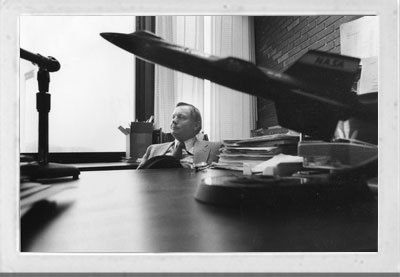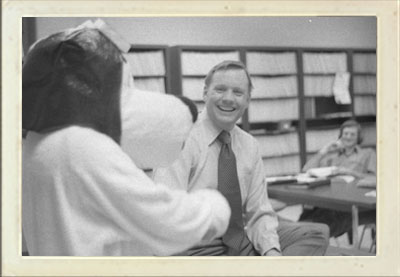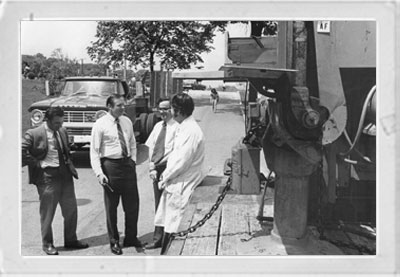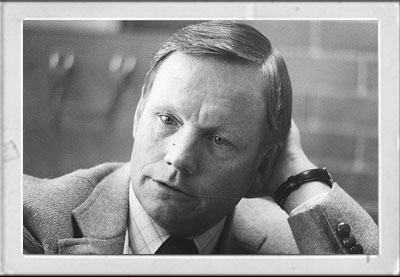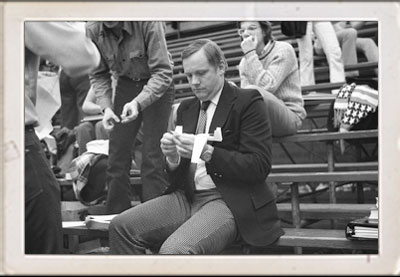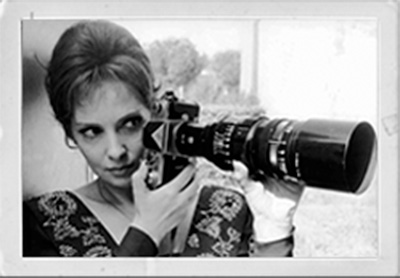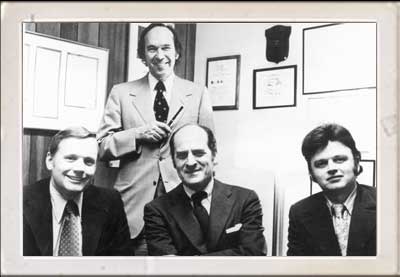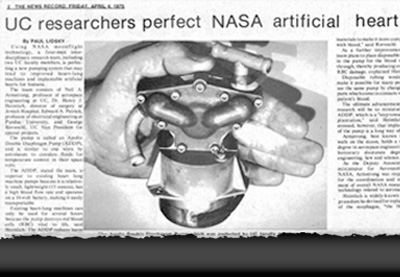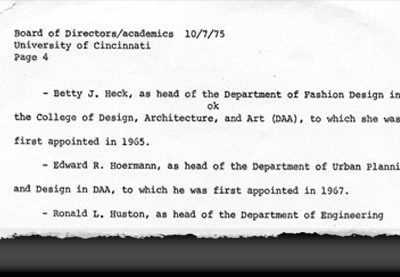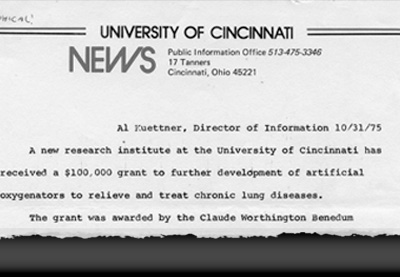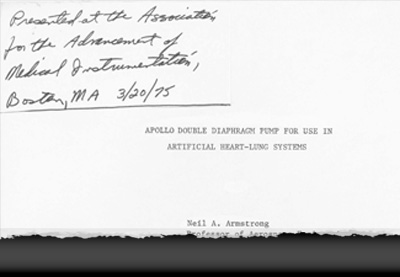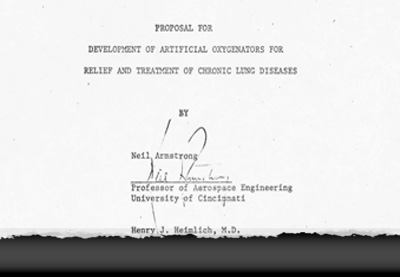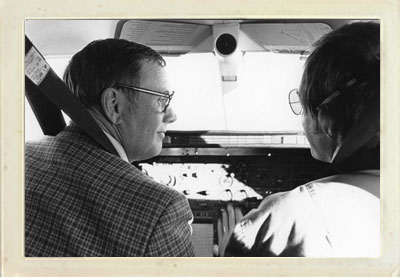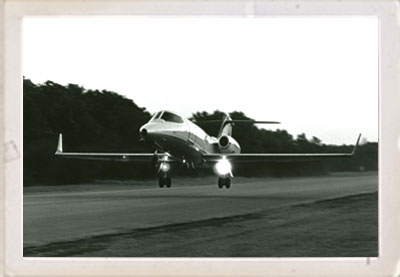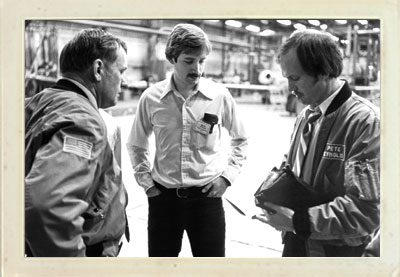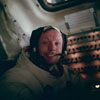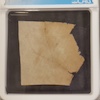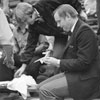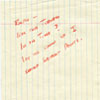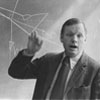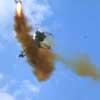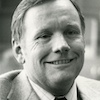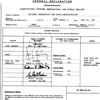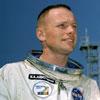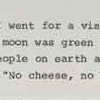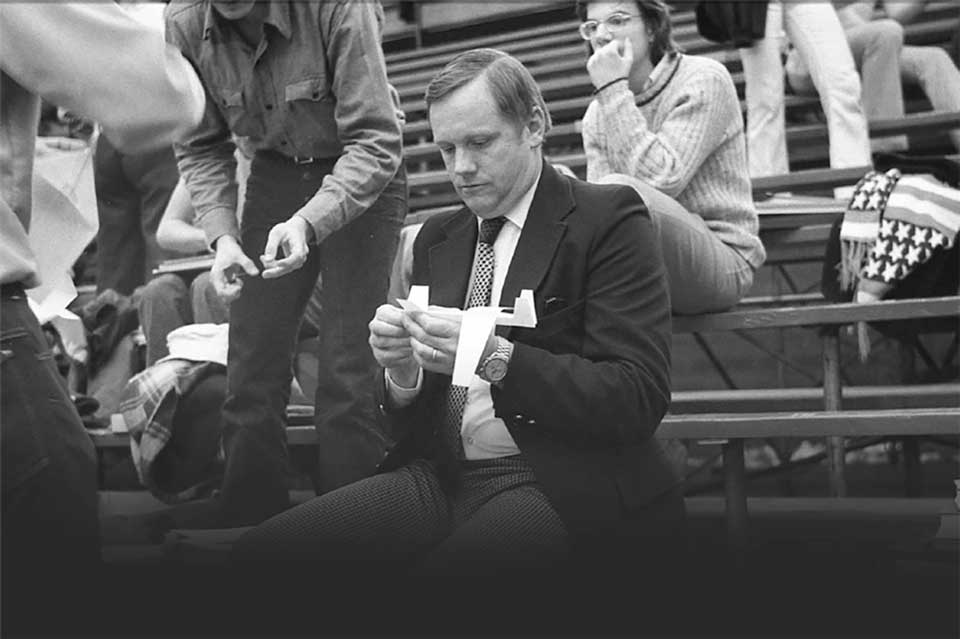
His Time at UC 1971-79
I am, and ever will be, a white-socks, pocket-protector, nerdy engineer. And I take substantial pride in the accomplishments of my profession. Science is about what is; engineering is about what can be.
— Neil Armstrong, February 2000, at National Press Club event including him among the 20th Century's Top 20 Engineering Achievements
Rememberance Essays
Remembering Neil Armstrong
by Gary Slater, Professor Emeritus
On Saturday, August 25, the United States and the world lost one of its greatest heroes. Neil Armstrong will forever be remembered as the first man to set foot on the moon on July 20, 1969 – an engineering triumph of the new United States space program. In the last few days there have been many eloquent eulogies for Neil, recounting his career and his pinnacle achievement of the first moon landing. I would like to add my thoughts on the passing of an American icon.
I was one of the 500 million people worldwide glued to a black and white TV in 1969 watching every bit of the Apollo 11 descent to the moon. I think my pulse rate was higher than Commander Armstrong's during the descent and to me the most immortal words were not those associated with the first step (“One small step for man …”), but rather the calm, almost routine sounding phrase after touchdown on the lunar surface "Houston: Tranquility Base here: The Eagle has landed." While writing this article I went back and watched the video of the descent and landing on YouTube and it rekindled those same emotions I felt when I was watching it live. The landing on the moon was a remarkable achievement that culminated the work of thousands of engineers and scientists who were working in the U.S. space program, and one remarkably talented pilot astronaut.
After Apollo, Neil Armstrong retired from NASA, and shortly afterwards in 1971 he joined the University of Cincinnati as a Professor of Aerospace Engineering. I came shortly after in 1972. I knew most of the faculty already (I had received my degree there several years earlier) but meeting Professor Armstrong as a colleague was something I will never forget. All the stories about his quiet demeanor, his sense of humor, his lack of ego, are all true. It is hard to imagine a more reluctant hero than Neil. He never really thought of himself as a hero – he was asked to do a job and he did it. Flying the Apollo capsule to the moon was no different to him than flying the X–15 research aircraft, or any one of the many other aircraft he flew during his career as a naval officer and as a NASA test pilot. As a faculty colleague we discussed aircraft flight dynamics (we both taught those courses), and for a few lectures of mine he even sat in the back of the room taking notes! Talk about pressure! Mostly we chatted about non–technical things. Over a beer at the faculty club we could discuss the soybean crop at his Lebanon, Ohio farm or other equally unremarkable current events. Remarkably, we never discussed the Apollo program – I was not going to initiate that conversation, and he never mentioned that aspect of his career.
He left the university quite suddenly in 1979 and for the most part lived a quiet life away from the limelight, and I had no personal contact with him after that. In recent years, however, he quite publicly expressed disappointment and concern about the direction of the space program. Retiring the Shuttle with no replacement in sight for years was clearly an issue for him. The nation that was first to the moon, that later built and flew the Space Shuttle, that built a massive space station now in orbit, now has to buy a ride to the station on a Russian rocket.
Neil Armstrong's final legacy is that of a reluctant hero who was a vital part of perhaps the most remarkable technical achievement in the history of mankind. Clearly NASA could not have chosen a more fitting person to carry the burden of that first Moon step. We will miss him greatly.
Remembering Neil Armstrong
by Ralph Spitzen, Eng '74, MBA '76
My classmates and I speculated that Neil grew up with two dreams. The first was to be a farmer. The other, to fly, took him on the journey of Apollo 11 atop the shoulders of a team of 400,000 people and the aspirations of countless others. The historic proportions of this voyage were entered over forty years ago in the timeline of the world.
There is great comfort to return to one's roots after a long and risky journey and no one deserved this more than Neil. Neil's purchase of a farm in Southwestern Ohio took him home and opened two new doors for him – farming and teaching future aerospace engineers how to push the envelope of man and machine.
Neil has been described as a reluctant hero, an iconic figure, and a test pilot's test pilot. My classmates and I had the great fortune to see another side of Neil – a great aviator who was comfortable making paper airplanes in UC's Armory Fieldhouse and a professor who enjoyed having beers with students after final exams. He showed frustration when his assistant was forced to interrupt class because a NASA administrator refused to wait for a call back but he tolerated the antics of our class when we got restless or when a famous Italian actress turned photojournalist converted our Baldwin Hall classroom into a photo–shoot backdrop. About that photo shoot, the photojournalist was Gina Lollobrigida, one of the most popular European actresses of the 1950s and 1960s. She recently photographed Henry Kissinger and Fidel Castro and was now in Cincinnati to capture images of Neil and his students.
Many have written that Neil had nerves of steel. I think he was a man with an extraordinary ability to adapt and learn both on the fly (no pun intended) and with incredible speed. Couple that with a sixth sense when it came to timing in the face of escalating risks and you have the right stuff to be Apollo 11's commander.
I remember my Control Theory professor set up a stability simulation problem using an analog computer. The goal of the simulation was for the operator pilot to use a joystick and keep a pen centered on a small plotter that was wired to the computer. Most of us could keep the pen centered for a few seconds, indicating we had the system under control, but then each of us lost control and the pen quickly skewed to an edge of the plotter indicating we crashed. Neil took his turn at the simulator. The professor then said that Neil just set the record for maintaining control the longest with this simulation.
Neil ejected from a flight of the Lunar Landing Training Vehicle as the Flying Bedstead (the LLTV's nickname) became unstable and spun out of control at about 100 feet above the ground. A half–second further delay in ejecting would have resulted in the parachute not opening in time. Neil landed safely and walked away suffering only from a bloody tongue. Weber Aircraft manufactured the ejection system and awarded Neil with the ejection handle handsomely mounted on a simple plaque. The plaque honored his entry into the Turtle Club where he joined other aviators who paid the price of admission by safely ejecting from their aircraft.
Alongside the Weber Turtle Club plaque in Neil's Rhodes Hall office was a prescription bottle with pills for motion sickness. The pills were not prescribed by a physician but rather presented to Neil by a Soviet Cosmonaut with best wishes for a safe journey to the moon and then back home. This was a most interesting gesture considering the state of the Space Race between the Soviet Union and the United States.
If I had the opportunity to ask Neil to reflect on his accomplishments he likely would have turned our discussion to the future and said something like – our teams achieved the dreams of generations but what's really important is what we do next.
The first man to walk on the moon also liked keeping his feet on the earth and his eyes to the sky and that's the Neil Armstrong my classmates and I knew.
Skill and Dedication
by Mark Stear, BSAsE, '78
Professor Neil Armstrong had that rare capability to present an aerodynamic concept on the blackboard in its theoretical form, then put down the chalk and turn to the class and describe a personal experience from his days as a test pilot to bring the concept to life. Through this process, my classmates and I gained a solid understanding of aerodynamics as well as a glimpse into the realities of flight–testing. We learned that even though things don't always go as planned, the laws of physics and aerodynamics always prevail.
Neil demonstrated that reality again during my first year as a performance engineer at Gates Learjet Corporation (Bombardier Aerospace Learjet today). Neil served on the Board of Directors at Learjet throughout most of the 1970s and the Board wanted some publicity for its new, high–performance Learjet Model 28. So, in February 1979 Neil set a timetoclimb record in the first production Learjet 28 from sea level to 15,000 meters (49,213 ft.) in 12 minutes, 26.7 seconds. I was one of two Learjet engineers selected to calculate the optimum climb profile used by the crew to set the record, and was on site with the support crew at First Flight Airport in Kitty Hawk, North Carolina when the mission was flown.
Just prior to boarding the Learjet 28 at Kitty Hawk, Neil approached the other engineer, Dave, and myself to discuss a last minute unexpected change in the takeoff profile. It seems that air traffic control had cleared the flight through an unrestricted climb corridor to the Southeast out over the Atlantic Ocean, but the runway orientation and surface winds at Kitty Hawk necessitated a takeoff to the Northeast. Neil explained that rather than a straight–out climb as he and his co–pilot, Pete Reynolds (a Learjet test pilot) had practiced in Wichita the day before, they would have to make a substantial right turn immediately after takeoff to establish the proper heading for which the flight had been cleared. Neil was asking us whether a gradual turn to the right while accelerating, or an immediate turn at low speed before accelerating would result in the lowest energy usage. Hmmm, Dave and I were scratching our heads and fumbling for our calculators when Neil suggested that an immediate right turn before accelerating seemed like the best choice to him. We looked at each other, still dumbfounded by the unexpected change in our carefully calculated mission, and simultaneously agreed, “Yup, sounds good to us Neil, we think that would be best!” To this day, I'm not sure we ever really knew which type of turning maneuver was best, but who was going to challenge the gut instincts of Neil Armstrong on an aircraft performance question?!
The resulting takeoff was quite spectacular as I watched the Learjet from the side of the runway make an abrupt right turn with a steep nose–up orientation at treetop level (do not try this at home) while leveling off for the initial acceleration to 250 knots before commencing the record climb. Less than 12.5 minutes later, a new world record had been set as the Learjet zoomed through 15,000 meters and the crew turned back toward a planned landing at Elizabeth City, North Carolina.
At this point, the flight test plan simply called for a gradual descent at idle power back to Elizabeth City, some 28 nautical miles from Kitty Hawk. To keep the plane as light as possible, only enough fuel to make the climb and return to base, with minimal reserves was loaded. Neil and Pete had practiced this mission several times in Wichita and we had good handle on the fuel required for the mission. What none of us had planned, though, was the fact that as they turned back toward Elizabeth City they now realized the winds aloft were blowing at nearly 100 knots, from the Northwest — direct headwind! What was planned as a leisurely descent at idle power quickly became an anxious seat–of–the–pants exercise in energy management to minimize fuel flow while maximizing forward ground speed. Fuel flow is lowest at high altitude, but that's where the strongest winds were. Neil and Pete were the two best pilots to handle this problem, and Pete later shared the story of their conversation in the cockpit while on a long final approach into Elizabeth City. The conversation reportedly went something like this: Neil: “How much fuel do we have, Pete?” Pete: “Well, the ‘LEFT’ tank reads 250 pounds, the ‘RIGHT’ tank reads 150 pounds, but if I put the selector on ‘BOTH’ it reads 500 pounds.” Neil: “Keep the selector on ‘BOTH’!”
The flight ended safely at Elizabeth City as planned and we all enjoyed a celebratory dinner that night at the hotel. The next morning as we gathered around the record setting Learjet Model 28 to prepare for departure, a Learjet mechanic climbed into the cockpit to start the engines and taxi the plane across the ramp for refueling. As the left jet engine roared to life and was settling to its idle speed, it had no sooner stabilized than it suddenly flamed out and quietly spooled down. The engine had quit from fuel starvation. That was it. There was no more fuel in the plane! We then realized just how close Neil and Pete (and the official NAA observer) had come to falling a bit short of their goal. Just as Neil's skillful piloting had landed him and Buzz Aldrin on the moon in 1969 with less than 30 seconds of fuel remaining, the same piloting skill and keen engineering instincts brought him to a safe landing in a Learjet ten years later with less than 30 seconds of fuel remaining.
After the plane was refueled that morning, I had the privilege of riding as a passenger in the same Learjet 28 with Professor Armstrong and Pete Reynolds at the controls, as we took Neil from Elizabeth City back to Cincinnati on that sunny Tuesday morning so he could teach his next class at UC! Though a few minutes late to class, it's clear that he was as dedicated to his students as he was to the board of directors.
It is rare that a professor of any subject can draw upon their years of real life experience to convey that subject to their students. UC and my fellow Aerospace Engineering students of the '70s had the privilege of working and learning from one of the best. He will be missed greatly by all who knew him.
Memories of Neil Armstrong from the Class of ’74
The BSAE class of ’74 was the first class that Neil taught at UC. Below are some comments from their reunion in 2000.
Most Useful Class
“Aircraft Design. In my last several co–op quarters and my first year and a half as an engineer, I worked on developing a preliminary design code for fighter aircraft design. I later worked on Winging–ground (WIG) aircraft design, before leaving DTNSRDC. At Wright Patt my job was primarily tactical systems focused from a systems perspective. At GEAE, I first worked ATOVL and then HSCT as a project manager, always from a systems perspective.”
—Fred Krause
“Aircraft Flight Testing with Neil Armstrong was the most useful class. On March 25, 1974, Italian actress Gina Lollobrigida came to class to photograph Neil and his students. Gina was also a successful photographer and was shooting some of the world's greatest people for women's magazines. Having already photographed Fidel Castro and Henry Kissinger, she turned to Armstrong. The classroom photograph with John Aicholtz, Rick Marickovich, Don Klick, and me appeared in the August 1974 Ladies Home Journal.”
—Tim Kinne
Memories
“The first day of class for Neil Armstrong. How after class he pushed us out the door, slammed the door shut to evade the army of reporters waiting in the hallway.”
—Dave Burrus
“I told my fourth grade nephew that Neil Armstrong was one of my college professors. When he told his teacher, she told him to ‘quit telling lies.’ She believed him after I wrote a letter.”
—Jim Kocher
“I remember sitting in our aircraft performance class with Andy Lee and just getting into one of those moods when I just couldn't stop laughing. Andy couldn't stop either. I have to idea what started it, but Armstrong threw us out.”
—Fred Krause
More memories from Tim Kinne
“One time during the end of the quarter of the first class, Aircraft Performance, that Neil taught at UC, Dave Burros said to Neil as he walked into the room, we have been kind all quarter, today you are going to tell stories. Now Neil had no idea that this was coming. So he told us a couple of very interesting stories, however, he was so brilliant that he worked his lecture around the stories.”
“I worked with him on an independent study class with Dr. Kroll. He was extremely helpful; he genuinely cared about my project and provided great insight into the problem I was working on.”
“Every nice thing that is said about Neil in the press is true. He was very kind and gentle, he was brilliant, he was business like, he had a dry sense of humor, and he always wanted to help others.”
Image Gallery
His Aircraft Flight Testing Class
View his class materials in the UC Neil Armstrong Commerative Archive Collection
Professor Neil Armstrong
Learn more in the UC Neil Armstrong Commemorative Archive Collection
He climbs to 50,000 feet in the Learjet Longhorn 28, setting five world records for business jets
Read more in the UC Neil Armstrong Commemorative Archive Collection
Armstrong Family Statement
For those who may ask what they can do to honor Neil, we have a simple request.
Honor his example of service, accomplishment and modesty, and the next time you walk outside on a clear night and see the moon smiling down at you, think of Neil Armstrong
and give him a wink.
—from the family of Neil Armstrong's statement upon his passing. August 25, 2012


